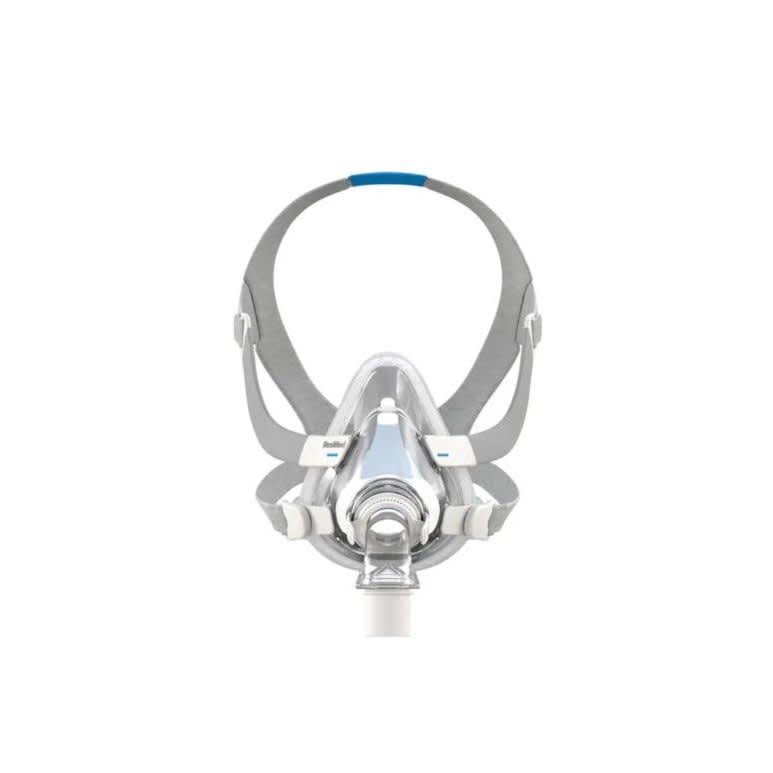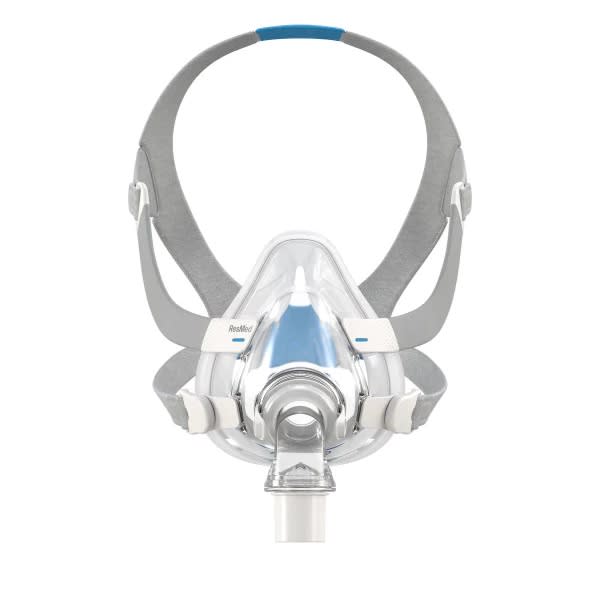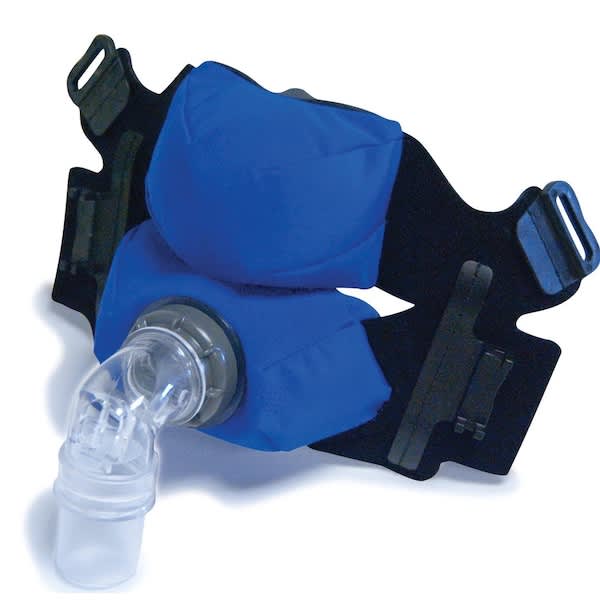On This Page
The Best Full-Face CPAP Masks
Our Top Picks
-
Best Overall
ResMed AirTouch F20 Full Face CPAP Mask with Headgear -
Best Fit
ResMed AirFit F20 Full Face CPAP Mask -
Best Value
Circadiance SleepWeaver Anew Full Face CPAP Mask
Best Overall

The ResMed AirTouch F20 Full Face CPAP Mask has a unique memory foam cushion that’s a great pick for people who don’t like traditional silicone masks. It also has a proprietary vent that helps keep exhalations quiet and a quick-release elbow that makes it easy to disconnect the mask from tubing.
Pros & Cons
Pros
- Memory foam cushion seals effectively without creating pressure points
- Quick-release elbow easily disconnects from the CPAP hose
- Vent minimizes exhalation noise
Cons
- Too bulky for some side sleepers
- Mask cushion cannot get wet
- Bottom tubing orientation may be cumbersome for stomach sleepers
Full Details
Best Fit

There’s a good reason the ResMed AirFit F20 is the company’s most popular full-face CPAP mask. It has a flexible silicone cushion that provides a comfortable seal, even at high pressure settings. The frame has soft, adjustable wings and there’s a quick-release elbow that makes disconnecting easy. Overall, it’s a comfortable and effective choice.
Pros & Cons
Pros
- Seals securely at high pressure settings
- Flexible frame sits below your field of vision
- Frame is compatible with other ResMed cushions
Cons
- Headgear may interfere with long, loose hair
- Cushion is too bulky for many stomach sleepers
- Pack only comes with one cushion size
Full Details
Best Value

This affordable mask has a cloth cushion that may offer a more comfortable alternative for people who don’t like the feel of silicone. It’s moisture-wicking and is an excellent option for active sleepers who need a mask that stays on all night.
Pros & Cons
Pros
- Cloth mask helps minimize red marks
- Worthwhile choice for people who can’t tolerate silicone
- Elbow rotates 360 degrees
Cons
- Only available in two sizes
- Lack of customization may result in mask leaks for some users
- Headgear isn’t compatible with other Circadiance cushion styles
Full Details
How We Make Our Picks
Our team chooses the best full-face CPAP masks by combining real-world user experiences with our expert knowledge. In addition to Dr. Breus, our team includes medical professionals, sleep coaches, and product researchers. Together, our decades of knowledge and regular research help us understand what makes CPAP machines and accessories effective.
To make our picks for the best full-face masks, we looked to verified reviews detailing comfort, user experience, and overall effectiveness. Fit and sleeping position are important to consider, so we took care to seek out a wide range of user experiences. We also analyze machine compatibility and stay current on product recalls and updates.
Should You Use a Full-Face CPAP Mask?
With all the CPAP mask options available, it can be hard to narrow down what kind to buy. While individual preferences vary, full-face CPAP masks are often best for people who breathe through their mouth during sleep and those who experience nasal congestion.
Who Should Keep Looking:
Benefits:
- Individuals who breathe through their mouth
- Back sleepers
- People prone to nasal congestion
Drawbacks:
- People with thick facial hair
- Side and stomach sleepers who have a hard time getting an effective seal
- Those who experience claustrophobia during CPAP therapy
Full-face masks have come a long way in terms of comfort. If you’ve tried them in the past and haven’t liked the feel, it might be time to try again. You can get memory foam cushions and soft liners that are comfortable against your skin.
What Other Types of CPAP Masks Are Available?
In addition to full-face masks, CPAP users can also buy nasal masks, nasal pillow masks, and hybrid masks. Each option helps alleviate sleep apnea symptoms by pushing pressurized air into breathing passages, but they have different delivery methods.
CPAP Nasal Masks
Nasal masks deliver air to the nasal passages by sealing around the nose. Some nasal masks cover the entire nose, while others sit just above the bridge.
Benefits:
- Not as big as many full-face designs
- Stomach and side sleepers may find them less prone to shifting than full-face masks
- May allow your doctor to prescribe a lower pressure setting than would be needed with a full-face model
Drawbacks:
- May require wearing a chin strap to keep your mouth closed
- Some users may experience air leaks near their eyes
- May cause dry mouth
Nasal Pillow Masks
Like nasal masks, nasal pillow masks deliver air to the nasal passages. However, this smaller mask style doesn’t extend up to the bridge of the nose. Instead, the mask seals below the nose and features silicone nasal inserts that extend just inside the nostrils.
Benefits:
- Typically smaller than other full-face masks
- Can be a good compromise for people who require oronasal therapy but find traditional full-face masks too bulky
- May offer a better fit for people who experience air leaks at the top of a full-face mask
Drawbacks:
- Facial hair may cause leaks
- May shift on active sleepers’ faces
- Side and stomach sleepers might experience disconnections or leaks
What Should You Consider When Choosing a Full-Face CPAP Mask?
There are a handful of factors to keep in mind when shopping for a full-face CPAP mask, including your sleeping position, budget, and the type of CPAP machine you own.
CPAP Full-Face Mask Considerations
| Price | Full-face CPAP masks vary widely in price, but most tend to cost between $75 and $200. Keep in mind that mask components require regular replacement and you should factor new cushions, headgear, and other CPAP machine costs into your budget. |
| Size and fit | Many masks come with multiple cushion size options and adjustable frames that are designed to fit many different face shapes. If you’re unsure which one to buy, you may want to consider a fit pack that includes multiple cushion sizes. |
| Device compatibility | While many CPAP masks work with any machine and hose with a standard 22-millimeter cuff connection, this isn’t always the case. A notable exception is the ResMed AirMini, a travel CPAP machine that’s only compatible with certain ResMed masks. |
| Sleeping position | Your sleeping position can affect how your mask fits. Side and stomach sleepers typically fare better with nasal pillows than full-face masks, while back sleeping is generally compatible with any mask style. If you need a full-face mask but aren’t a back sleeper, you can buy a CPAP pillow that helps prevent the mask from dislodging. |
If you breathe through your mouth, a full-face CPAP mask is probably the best style mask for you. The edges seal against your face to prevent leaks and make sure no air escapes.
Is a Prescription Required for a CPAP Mask?
You need a prescription to purchase a CPAP mask. If you buy a CPAP mask online, you’ll need to provide a copy of your prescription to the retailer. In stores, you can typically show your physical prescription. Individual mask replacement parts are available without a prescription.
Will Health Insurance or Medicare Cover a CPAP Mask?
Many health insurance providers cover CPAP masks, though there can be restrictions and you’ll likely need to meet your deductible first. To use Medicare for CPAP coverage, there are specific steps to follow that include a three-month trial period and meeting your Part B deductible. Check with your provider regarding your specific coverage for CPAP therapy.
Where Can You Buy a Full-Face CPAP Mask?
You can buy full-face CPAP masks online and in brick-and-mortar medical supply stores. While shopping at a physical store offers personalized service, online retailers often have a wider selection of masks at more competitive prices.
Frequently Asked Questions
A full-face CPAP mask works by creating a seal over the mouth and nostrils and delivering pressurized air to breathing passages. This helps prevent upper airway collapse to minimize symptoms related to obstructive sleep apnea.
You can clean a full-face CPAP mask by gently washing the cushion, frame, and headgear with warm water and mild soap. Make sure to look at manufacturer recommendations, because directions vary depending on material type. For instance, memory foam cushions shouldn’t be washed and only need to be wiped clean.
CPAP replacement guidelines call for full-face mask interfaces to be replaced once a month, the mask frame every three months, and the headgear twice a year. However, this is general guidance, and you should check manufacturer recommendations to learn about your mask’s replacement schedule.
If you have long hair, you can wear it in a braid to prevent it from getting caught in your full-face CPAP mask. Low ponytails and sleep caps can also help keep your hair from getting matted. If you wear your hair loose, the headgear may slip off and cause tangles.
